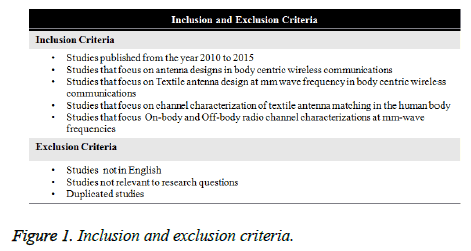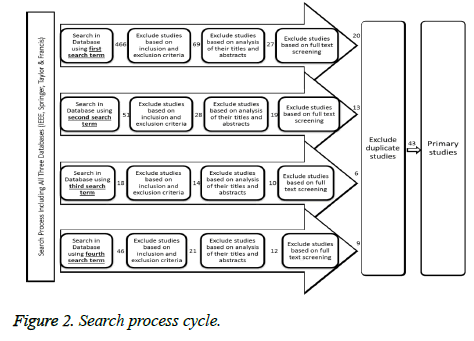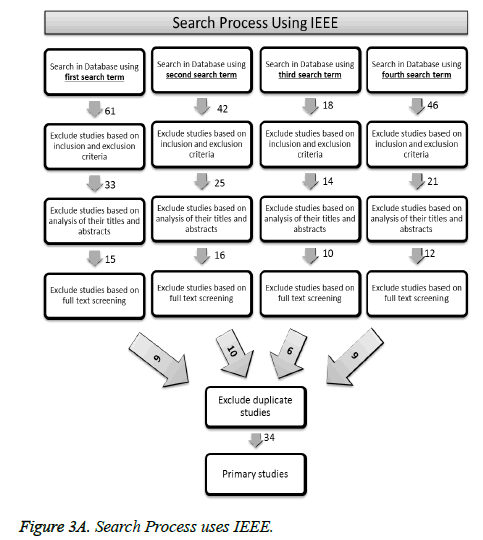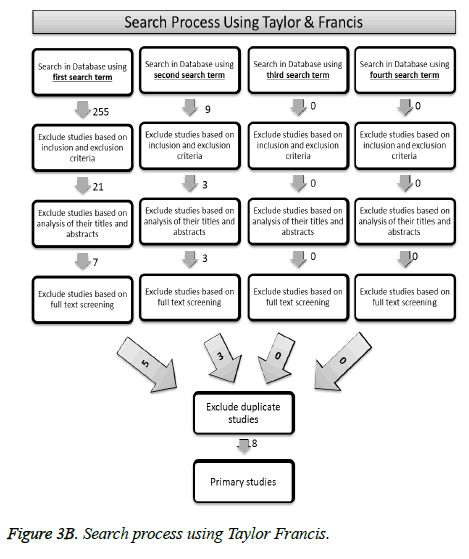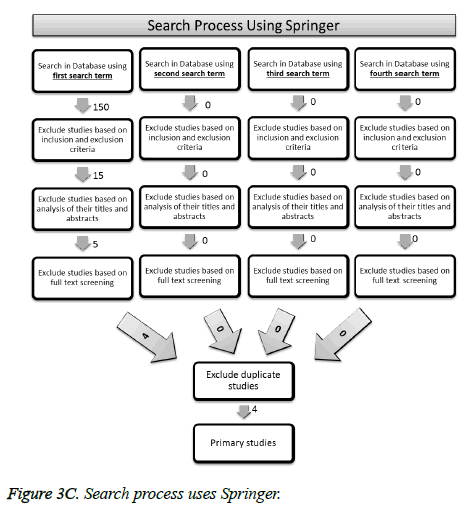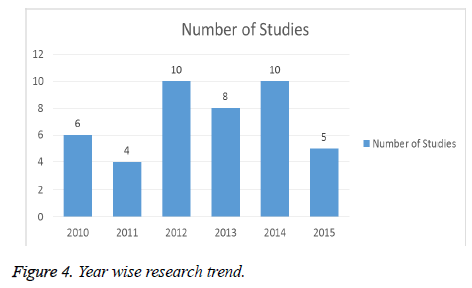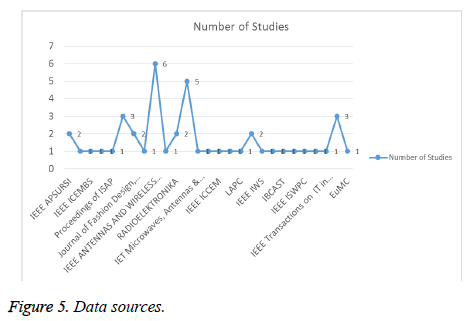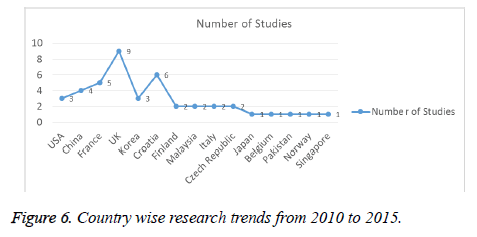Review Article - Biomedical Research (2017) Volume 28, Issue 8
Wearable textile antenna design in body centric wireless communications: a systematic literature review
Saadat Hanif Dar* and Jameel AhmedDepartment of Electrical Engineering, RIPHAH International University, Islamabad, Pakistan
- *Corresponding Author:
- Saadat Hanif Dar
Department of Electrical Engineering
RIPHAH International University, Pakistan
Accepted date: January 24, 2017
Abstract
In the recent years, the Textile antenna design has become an attractive research area to its persistent ehealthcare applications. Wearable antennas are becoming widespread and their demands are significantly increasing sense of their use in smart clothes in wireless communications. This paper reviews design and applications of various wearable textile antennas used in body-centric wireless communications. Ordinary, fabric is normally used as a substrate that presents a very low dielectric constant and reduces the surface wave losses and bandwidth. Wearable antennas are used in close proximity with human body and antennas continuously exchange water molecules from the surrounding environment due to these electromagnetic properties are biased. This paper, presents a systematic literature review for the design and development of wearable textile antennas from selection of fabric material to edging of antennas. Primary studies involved in this work are identified through a selection process and clearly stated inclusion exclusion criteria. Further, survey results are presented and the outlook for further study is summarized.
Keywords
Body-centric wireless communications, Body-area networks, Textile antenna, Textile materials, Channel characterizations
Introduction
Wireless body area network (WBAN) is a collection of small and lightweight sensors placed inside or outside the body to monitor the function and the environment of the human body [1]. The network of such intelligent systems allows the doctors and medical staff to continuously monitor the health of patients and acquire the feedback [2]. Very minute sized microelectronics, sensors installed on the body or clothes or even implanted inside the human body, convert the main parameters (Blood pressure, Sugar level, Oxygen level etc.) into electrical signals and are transmitted to the base station. These parameters are remotely monitored and provide the lifesaving drugs through the actuators implanted on the human body [2]. Body worn systems are growing with the solution to cope with the challenges of ubiquitous monitoring of people in healthcare. Textile materials are commonly used and easily available are promising materials to design and develop wearable antennas for in-and on body area networks. Thin and robust fabric antennas integrated in RF circuits are capable to sense, communicate and harvest data in BAN’s.
Antennas are main elements in the design of body centric wireless communications. Various types of textile antennas are designed in the recent years and they satisfactorily transfer power between different nodes placed on a human body. Antennas in body-area networks need to be compact in size and light weight, feasibly allowing for integration with clothes. An antenna designed at 400MHz to 10 GHz in close proximity to the human body experiences radiation, frequency detuning and changes in impedance and efficiency [3]. Antennas for body centric wireless communications include Inverted F antenna (IFA) [4], Low-Profile microstrip antenna [5], Wearable (Fabric) and Sleeve Antenna [6-9]. Wearable antennas placed in close proximity with the human body are affected by the biological tissues and antenna performance deteriorates [10]. Various dielectric characteristics of the human body vary at millimeter and microwave frequency range [11]. Moreover, the dimension and size of a human body are electrically higher at millimeter frequencies associated with microwaves. In this paper, we reviewed various antennas made from textile material and easily integrated into clothes. Antenna performance near human tissues is analyzed and reviewed. Various Common antenna parameters like radiation pattern, return loss, gain in dB and antenna efficiency are taken into account to appraise the performance of wearable antennas.
Research Methodology
This research work has been done by means of a Systematic Literature Review (SLR). An SLR is a literature review that focuses on predefined research question(s) that tries to recognize, select and analyze all the research evidences relevant to that question(s). The research process was followed stages and is explained in subsequent sections:
• Developing review protocol
• Defining exclusion and inclusion criteria
• A defining search process which shall be followed to find relevant studies
• Quality evaluation
• Data accumulating and analysis.
Review protocol
Following the SLR guidelines and procedures [12], we framed a review protocol. The protocol identifies the context for SLR and research questions based on that context or field of study. Basically, research questions act as a problem statement for the research. Review protocol also defines the search strategy, criteria for selecting studies, getting out data from the selected studies and analysis of that data. Section 1 describes the context of our research as well as the research questions that we are addressing in our research. Other parts of the review protocol are discussed in the sections below.
Exclusion and inclusion criteria
The basic reason of planning this criterion for selection of studies is to find all the relevant work/studies in this research. Research Papers from popular databases (IEEE Explore, Taylor & Francis, Springer journals), workshops and conferences available over the period of 2010 and 2015 are considered. We set the lower search borderline on the publication year to 2010 as we wanted to consider the latest studies relevant to our topic stored in the database. Figure 1 shows the exclusion and inclusion criteria for the systematic review. The selected study must satisfy one of the inclusion criteria and studies that fulfil any condition from exclusion criteria must be excluded from the list of primary studies.
The search process
We restricted our search in scientific databases, as most of the material in books is referenced or discussed in publications stored in electronic databases. There are various electronic databases; however, IEEE Explore is a huge database with high impact publications covering the field of textile antenna in body centric wireless communications. Search terms used in our research to find related studies include:
S1. Antenna design techniques in body centric wireless communications
S2. Textile antenna design at mm wave frequencies
S3. Channel characterizations of textile antenna matching in human body
S4. On-body and off-body channel characterization at mm wave frequency
The selection process used for studies was based on multiple steps and these steps are:
Step 1. Search in the database to identify relevant studies by using each search term individually
Step 2. Exclude studies grounded on the inclusion, exclusion criteria
Step 3. Exclude irrelevant studies based on scrutiny of their titles and abstracts
The results of the search process cycle of all three databases IEEE, Springer and Taylor & Francis are shown in Figure 2. In the first stage search process for IEEE is explored in Figure 3a. With the search term S1, a total of 61 publications was identified and after applying inclusion and exclusion criterion 32 publications were selected. 15 publications were sorted on the basis of most relevant abstract and finally 9 studies were acknowledged as primary studies where the contents match with the relevant research area.
For the second search term S2, 42 publications have been identified and then again imposing inclusion, exclusion criteria 25 publications were filtered and finally 10 papers were selected as primary studies. For the third search term S3, 18 publications have been identified. After checking these publications against inclusion and exclusion criteria 14 were identified and finally 6 publications were selected as primary studies. IEEE Explore has reported 46 publications for the fourth search term S4, further after inclusion, exclusion criteria 21 were sorted and 12 identified on the basis of abstract selection, finally 9 publications are selected as primary studies. Search cycle using Taylor & Francis is shown in the Figure 3b. For the first search cycle S1, 255 publications are reported in the database. After applying inclusion and exclusion criteria 21 are identified and 7 are selected on the basis of the abstract. Finally, 5 publications are selected as primary studies. For the Second search term S2, 9 studies are reported and after removing duplicate studies only 3 publications are selected as primary studies. For the third and fourth search terms no relevant publication was identified. Springer search cycle shown in Figure 3c has reported 150 publications for the first search term S1.No results were reported for the second, third and fourth search terms.
Quality assessment
To summarize the findings of the included studies a quality assessment criterion is defined in which each study has been compared. The studies are based on antenna type used, including its bandwidth, the nature of the substrate and its conductivity and permittivity. The quality assessment attribute includes:
• The study includes theoretical framework/reasoning/survey results/implementation statistics instead of just studying the existing literature and writing non-justified statements.
• The study gives background on the topic of research clearly.
• The study clearly states the research methodology used for data collection and as well as for validation of results.
To assure the credibility and quality of selected studies all the studies must fulfill the above quality attributes.
Data extraction and synthesis
By reading all of the selected papers relevant material from each study was extracted. To summarize the extracted information, comparison of these studies was performed on the bases of data extraction parameters. These parameters along with the description of values for each attribute are shown in Table 1.
| Data Extraction and Synthesis | |
|---|---|
| Data Extraction Parameters | Description |
| Bibliographic Reference | Author, Title, Sources and Year of Publication |
| Type of work/study | Book, journal paper, conference paper, workshop paper |
| Context of work/study | Main topic area and objective of the study |
| Wearable antenna Type | What type of wearable antenna is under consideration |
| Antenna bandwidth | Antenna Bandwidth under consideration |
Table 1. Data extraction and synthesis.
Temporal view
Trends in research area according to year of publication: Research trends in the field of wearable textile designs since 2010 are shown in the Figure 4. In the year 2010 significant research has been done, and then the graph goes down but since 2012 trends reflect a realization of research in this area.
Overview of Results from SLR
All included studies are listed in appendix. In this section these papers are described according to the publication sources. A temporal view of the selected studies is also presented.
Data sources
Most of the work mentioned in this paper is published in high impact factor journals, IEEE conferences and workshops. Figure 5 shows the summary of distribution of sources for all the publications. All papers satisfy quality assessment criteria mentioned earlier. Each source of study is mapped against number of publications under it. The graph shows the contribution of each source in the field of textile antenna design. “IEEE antenna and propagation letter” can be seen as the most active community in it.
Research trends according to country wise distribution: Figure 6 shows the research trends in various countries. Wearable systems have been studied well in the UK, Korea, USA and Croatia. The graph shows the major countries where research was carried out. It can be readily seen that many studies of textile antennas are conducted in the UK and Croatia. The document is based on the nationality of first author.
Wearable Textile Antenna Design in Body Centric Wireless Communication: Summary of Approaches
Modeling framework of electromagnetic simulators is computationally expensive. An unusual tactic is to use an equation-based models [13,14]. However, the equation-based modeling has the demerit that it is difficult to develop new architectures with low accuracy developed ratio.
Textile antenna designs; summary of approaches
Studies in Table S1. Summarize various types of antennas with the nature of substrate selected for designing and developing textile antennas. Results show that regular textile material has been used as a substrate. However, slight information can be found on the electromagnetic waves properties of regular textiles.
Textile antenna design requirements: summary of approaches
The included studies in Table S2 summarize the textile fabrication methods and nature of substrates used for on-body communication systems. Textiles antennas are designed subject to their performance in bending and the crumbling condition of the human body. Results have shown their satisfactory performance in terms of bandwidth, gain, and efficiency and radiation pattern.
Textile antenna matching in proximity with human body, summary of approaches
Table S3 summarizes the results that if the antenna is not flexible enough to accommodate changes in human body tissues, then the wearable systems will reduce its importance and life as well. The results indicate that performance of original antenna is changed due to the existence of the human body model, and the antenna needs to be designed for on-body environment.
On-bod and off-body channel characterizations at mm wave frequencies, summary of approaches
Studies in Table S4 briefly review the recent progress in antenna and propagation for body-centric wireless communications. It is summarized that human body effects on off-body antennas are very weak and on-body antenna characteristics depends on antenna distance.
Conclusion
The Antenna is a key element in the design of body-centric wireless communications. Our study examines the design aspects of various wearable antennas and human body effects on its performance. A systematic review was performed in order to understand recent trends in wearable design systems. This SLR discloses that flexible wearable antennas are plainer in nature and they radiate electromagnetic waves perpendicular to planar structure. Antenna ground plane efficiently protects the human body. The major Parameters like bandwidth and efficiency of the planar micro strip antenna are primarily determined by the substrate dielectric constant and its thickness.
Future Work
As mentioned earlier, we have selected studies from only three databases i.e. IEEE, Taylor &Francis and Springer. This limits the range of our research and the work can be extended by exploring research studies published in various other databases. We plan to explore other databases in future as well. For the future textile antenna designs it is proposed that their radiation efficiency needs to be improved and antenna size needs to be reduced, further to this feeding arrangements must be suitable to wear on clothes. In the future, we plan to design betterquality electro-textile antenna that will offer resistance to water, humidity and sweating.
References
- Ullah S, Higgins H, Braem B. A comprehensive survey of wireless body area networks on PHY, MAC, and network layers solutions. J Med Syst 2012; 36: 1065-1094.
- Latr´e B, Braem B, Merman I, Blondia C, Demeester P. A survey on wireless body area networks. Wireless Networks 2011; 17: 1-18.
- Van Dam K, Pitchers S, Barnard M. Body area networks: Towards a wearable future. Proceedings of WWRF kick on meeting, 2001.
- Zhen B, Li HB, Kohno R. Networking issues in medical implant communications. Int J Multimedia Ubiquitous Eng 2009; 4: 23-38.
- Hall PS, Ha Y. Antennas and Propagation for Body-Centric Wireless Communications. Artech House, London, 2006.
- Khan I, Hall PS, Serra AA, Garlic AR, Nepal P. Diversity Performance analysis for On-body Communication Channels at 2.45 GHz. IEEE Transact Antennas Propagation 2009.
- Scanlon WG, Conway GA, Cotton SL. Antennas and propagation considerations for robust wireless communications in medical body area networks. IET Seminar on Antenna & Propagation for Body-Centric Wireless Communications, London, UK, 2007.
- Khan I, Hall PS, Serra AA, Garlic AR, Nepa P. Diversity Performance analysis for On-body Communication Channels at 2.45 GHz. IEEE Transact Antennas Propagation 2009.
- Hertleer C, Rogier H, Vallizzi L, Van Langenhove L. A Textile Antenna for Off-Body Communication Integrated Into Protective Clothing for Firefighters. IEEE Transact Antennas Propagation 2009; 57: 919-925.
- Galehdar A, Thiel DV. Flexible, Light-Weight Antenna at 2.4 GHz for Athlete Clothing. IEEE Transact Antenna Propagations 2007: 4160-4163.
- Santas JG, Alomainy A, Hao Y. Textile Antennas for On-Body Communications: Techniques and Properties. IEEE Antenna Propagation 2007.
- Zwick AT, Wiesbeck W. UWB antennas for communication systems. Proc of IEEE 2012; 100: 2308-2321.
- Zhadobov M, Chahat N, Sauleau R, Quément CL, Dréan YL. Millimeter-wave interactions with the human body: State of knowledge and recent advances. Int J Micro Wireless Technol 2011; 3: 237-247.
- Laredo JA, Ranjan R. Continuous improvement through iterative development in multi-geography. Third IEEE Int Conference Global Software Eng 2008.
